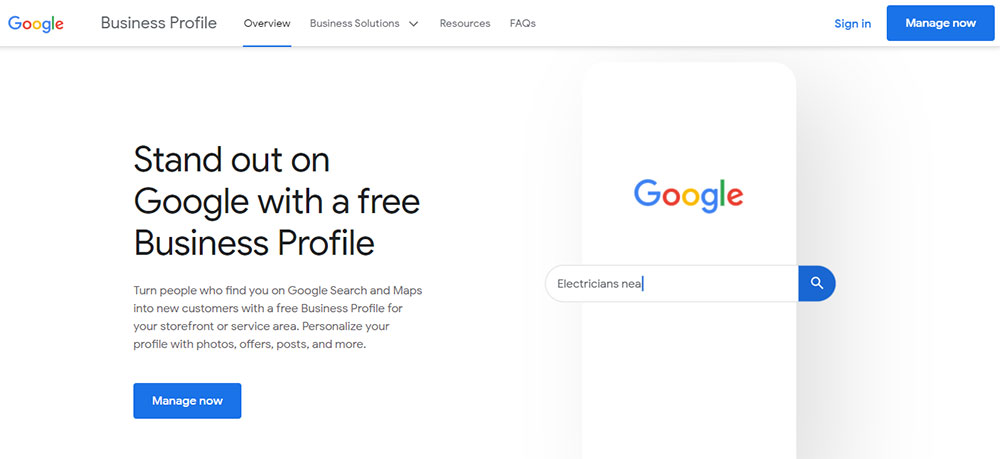Physical therapists are in a competitive industry which means their SEO (search engine optimization) must be up to par to compete online. SEO is a crucial element of your digital marketing campaign and an effective way to get patients through your doors.
So, how do you find new patients? Or, should we say: How do new patients find you?
Getting your website in front of your target audience is the answer. This is done through a strategic search engine optimization (SEO) campaign. Whether you’re a physical therapist new to SEO or have been utilizing it for years, this post will give you invaluable insight into creating a stellar SEO campaign that makes your visitors, Google, and ROI happy.
We’re going over:
- What SEO is
- Why SEO is crucial to your success
- The three pivotal SEO steps every physical therapist needs to take
- What to know about your Google Business Profile
- And more
If you’re a physical therapist looking to get more business in your clinic, SEO is the best place to start, so read on to learn all about it.
What is SEO, and Why is it Important?
SEO is how website users find you online. It’s the process of becoming visible to the right audience at the right time. About 99,000 Google searches are completed every SECOND. That’s over 8.5 billion a day. If you’re not trying to compete with your other local physical therapist online, you’re behind the curve.
Here’s how it works if a user searches for a physical therapist near them:
- Without SEO, you’ll be one of many physical therapists hidden within the hundreds (and hundreds) of Google results pages (if you’re lucky)
- But, with SEO (done right), you can be one of the first physical therapists to show up as a result on page one of Google’s results pages
It’s really just as simple as that.
Think about how many SERPs (search engine results pages) you go through after you get a query answered. Do you look past the first five? Ten? Here’s a nugget to know: Google receives over 75,000 searches a second, and 67% of clicks go to the first five results provided.
If you don’t have a working SEO campaign, your clinic is missing out on new patients. Your clinic needs new patients to thrive. Hence, you need a working SEO campaign to help make that happen.
The BEST 3 Physical Therapist SEO Steps
SEO encompasses many aspects; it’s not a quick fix. In fact, it’s well known for being a long-game yet highly effective digital marketing strategy. The key is just to get it started. Don’t get bogged down in overwhelm.
Start small; it will grow.
We’re giving the three most important SEO steps for physical therapists so you get quality visitors to your website (you know, the ones that take the actions you want them to).
Step 1: Identify Your Place in the Market
Knowing who and where your audience is is instrumental in how you talk and where you go to reach your best patient (aka your target audience). Your target audience is also called your buyer persona, and determining your buyer persona is step one of the SEO process
Your target audience consists of those you want to work with, those you want to visit your website, those you want to take action on your website, those you want to connect with. So, you must ensure you’re showing the content they want to see wherever they are online.
What’s that mean?
It means if your ideal patient is on Facebook, that’s where you are. If they’re asking questions on Query, that’s where you are. If they’re looking at Yelp, that’s where you are. If they’re regularly looking at your competition’s blog, you need to get them over to yours.
Places you will likely want to show yourself include:
- Google and Google Maps (Google Business Profile, more on that below)
- Bing
- Yelp
- Apple Maps
- All relevant social channels, such as Facebook, Instagram, YouTube, and X (formerly Twitter)
So, how do you find where your target audience is? Let’s find out:
- Figure out the audience you want as patients.
- If you already have some of those, analyze them and learn their demographics (age, sex, geographic location, income, interests, etc.); do this through engagement, such as with surveys.
- Check out your competition. Do they have the patient base you want? Look at their web pages, keywords, blog posts, videos. Don’t copy them, but get an idea of how you can turn that voice into your own and snag those patients for yourself. It’s not cheating; it’s smart marketing.
- Use Google Analytics. It’s a free tool that offers invaluable insight into how your website performs, what your users are doing, and how you can improve their experience.
- Get on social media and use their analytics. This will help you be a superhero with social posts because you’ll know exactly what’s working for your audience. Facebook Audience Insights is a great way to tailor your strategy.
- Speaking of social media, use hashtags! People follow and search for hashtags, so use the ones you want to show up for. Plus, they can be a fun way of connecting with your audience and adding a bit of humor.
- Research the demographics you want to cater to.
Need help finding your buyer persona? Try these for help:
Once you know more about your buyer persona, you can create compelling content. And the number one step for this part is finding your keywords.
Keywords
Your keywords are a crucial part of your content strategy. In order for Google to provide you, as a result, the words your searchers are using to find you must match the words you use in your content.
Finding quality keywords may sound daunting, but it’s really not. There are numerous tools to help you (many are free):
But Google’s search bar itself can get the ball rolling.
For example, you want to rank for the term “pain management,” so you type into the search bar: “physical therapist for pain management.” Then, sit back and read what populates. This will help give you a good idea of what people are searching for.
Check out our Ultimate Guide to Keyword Research for SEO for some info and inspo.
Step 2: On-Page SEO
On-page SEO entails optimizing your website’s content to improve its search engine ranking by getting visitors organically (or through un-paid means, such as pay-per-click campaigns).
Several elements are involved with on-page SEO, the main ones being using your keywords (which you know all about now) within quality content on an awesome website.
Physical therapist website design
Our next on-page SEO tip is about your website. Your website is usually the first impression you make on a potential patient, so make it a good one. And this is a two-part process involving what your visitor sees and how your website responds.
You need to optimize each page of your website on every level, ensuring Google and the user experience are both satisfied.
What’s that mean?
Here’s what to prioritize when creating and optimizing your website:
- Your website pages must load quickly (we’re talking under two seconds)
- Content must have ZERO grammatical and spelling errors
- Every page should look amazing on a handheld device, laptop, and desktop
- Make CTAs (calls to action) easy to see and clickable, taking the visitor where it promises to
- Your website images and videos must be clear and high-quality
- A navigation bar that is easy to find (at the top or left of each page) and understand
- A consistent footer that has your contact information, map and directions, clickable pages, and any other relevant information
Here are the important pages to have within your website (in no particular order):
- Homepage
- Conditions page- tell them what you fix
- Services page- tell them how you fix it
- Your blog
- Contact Us page
- Book an Appointment page
- About Us page
The goal is for your users to find everything they need quickly and easily and know that your physical therapy clinic is for them based on your web design.
And, hey, you won’t be for everyone, and you shouldn’t want to be. How stressful. You’re here for your target audience ONLY. Design with them in mind.
Quality content for your physical therapy clinic
Quality website content is vital to your SEO strategy. It’s an on-page SEO solution that tells your target audience everything they want to know. In doing this, Google provides you as a result for the optimal user with the optimal search request.
Your content must be:
- Excellent
- Relevant
- True and trustworthy
- Unique
- Informative
- Educational
- Inspiring
- Entertaining
Stay on brand, but ensure your content has most, if not all, of these things, and you’re golden.
Here’s the deal: you know who your target audience is. So, if you know your buyer persona, you know how they’re searching and what they want to see. Create content based on that.
Obviously, this is simplifying; creating high-quality content can be time-consuming and takes thought, but like you’ve heard since you were a kid, practice makes perfect.
Content consists of:
- Your blog (yep, you should have a blog)
- Your web pages (everything on them: words, images, videos, etc.)
- Your YouTube channel
- Your social channels (yep, you should have social channels- you can advertise your blog posts on them, sending users to your site)
- Infographics
- White papers
- Podcasts
- Case studies
- eBooks
- Maps
- Guides
- And more
Basically, there’s no shortage of content ideas for you to choose from.
Blog is often a scary 4-letter word that no physical therapist wants to think about.
These will help:
- Creating Quick & Effective Blog Posts: The Template Approach
- 10 Fierce Blogging Tools to Make the Process More Efficient & Effective
- The Anatomy of an Effective Blog Post
- Blogging 101: How Do I Write Great Blog Posts?
We’d be remiss not to mention the elephant in the room. AI. Can you create content using AI? It’s a question we’re getting more and more.
And there’s no black-and-white answer; it’s a bit complicated, so check out these resources to learn more about it:
- 3 ChatGPT Mistakes That Can Hurt Your Clinic’s Marketing & SEO
- ChatGPT SEO & Content Marketing Prompt Cheat Sheet
However, you can definitely use AI to HELP you create fantastic content.
Should you rely solely on what AI provides? No way.
The big takeaway about content is that you want your users to come to your website for valuable information, and you want them to keep coming back. So keep it fresh and updated, make it easy to share, and prove yourself to be the authority you know you are when it comes to physical therapy.
Other elements of excellent on-page SEO to include on or on the backend of your pages:
- Title tags: creating the clickable headline of your page that shows up in the search engine results pages (SERPs); it should be on-brand and informative
- Meta descriptions: creating the short description of your page that goes under the title tag on the SERPs
- Internal linking: linking between pages of your website whenever relevant
- Page speed: ensuring your pages load quickly (in under two seconds)
- Mobile-friendly: ensuring your pages load fast and well on handheld devices
- Alt text: adding a description to images to help screen-reading tools describe images to visually impaired visitors and allow the search engine bots to better understand your pages
- Images and videos: adding visual elements to your pages that create a better user experience

Image from Google Business Profile
Step 3: Off-Page SEO
Off-page SEO is the optimization that occurs off your website; it also includes many elements, so let’s get to them.
Optimize your Google Business Profile (GBP) for Local SEO
You likely have a brick-and-mortar (physical location), so the way to ensure Google knows that is to get yourself a local SEO campaign and set up your GBP listing.
Local SEO involves improving your clinic’s visibility in local search results, so you get more organic traffic to your site from patients who are close by. This is important to local businesses. If your clinic is in Hoboken, NJ, you wouldn’t need your website showing up to a potential patient in Milford, CT, no matter how ideal they are on every other level.
Here’s to make your local SEO campaign great:
- Create and manage a Google Business Profile (more on that below)
- Develop individual location website pages and optimize each location’s Google Business Profile
- Create listings on other third-party sites, such as yellowpages.com
- Post content regularly (on your blog and social channels)
- Encourage customers to leave reviews
- Identify and use relevant local keywords
- Create consistent NAP citations (name, address, phone number)
As mentioned, your GBP is a big deal. Setting up your free GBP listing is super simple, and it’s how you appear on Google Maps and in Google Search, so if you haven’t done it yet, you should do it now.
Your GBP allows you to:
- List your business location
- Display important information
- Connect with customers
- Post updates
- List your products and services
- Share your menu
- Control your business information
Some information you can add to your Google Business Profile includes:
- Contact details
- Website link
- Opening and closing times
- Phone number
- Health and safety measures
- Photos
- Logo
- Create Google Posts
- And more
Google determines local search ranking based on three factors: relevance, distance, and prominence.
Other important (and free) tools and directories to help with off-page SEO include:
Link-building
Link-building can occur on and off your website. We went over the internal linking. But you can garner a highly effective Google (and user) response when other relevant, authoritative, and trusted websites link to you. These are called backlinks.
Obviously, getting backlinks isn’t as easy as dropping links into your own site, so you may have to put in some legwork. Networking can be a great benefit for a link-building campaign. It also provides ample opportunity for more off-page SEO strategies.
Other ways to achieve impactful off-page SEO:
- Influencer marketing: getting influencers relevant to your business to support your brand
- Having events: hosting events at your clinic with relevant speakers gets you in front of a new yet likeminded audience
- Speak at events: speaking at others’ events does the same
- Get involved in the community: partnering with local businesses encourages more patients
- Forums: answering questions and getting involved in discussions on popular forums demonstrates authority
- Guest blog: blogging on other sites helps reach a broader audience
Mastering Physical Therapy SEO
These tips and tools can get your SEO campaign moving and give you all that positive attention from Google, so start implementing ASAP! If you need further guidance, please book your free discovery call with us at Propel. We’ve worked with numerous clinics, helping them achieve their online marketing goals, and we’re confident we can help you, too.








![How to Write a Professional Chiropractic Bio [Template Included]](https://propelyourcompany.com/wp-content/uploads/write-a-bio-500x383.jpg)

